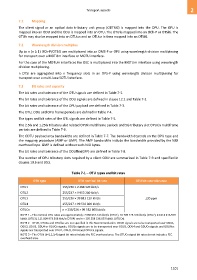Page 1111 - 5G Basics - Core Network Aspects
P. 1111
Transport aspects 2
7.1 Mapping
The client signal or an optical data tributary unit group (ODTUG) is mapped into the OPU. The OPU is
mapped into an ODU and the ODU is mapped into an OTU. The OTU is mapped into an OCh-P or OTSiG. The
OTUk may also be mapped into an OTLk.n and an OTLk.n is then mapped into an OTSiG.
7.2 Wavelength division multiplex
Up to n (n ≥ 1) OCh-P/OTSiG are multiplexed into an OMS-P or OPS using wavelength division multiplexing
for transport over a MOTUm interface or MOTU interface.
For the case of the MOTUm interfaces the OSC is multiplexed into the MOTUm interface using wavelength
division multiplexing.
n OTSi are aggregated into n frequency slots in an OPS-P using wavelength division multiplexing for
transport over a multi-lane SOTU interface.
7.3 Bit rates and capacity
The bit rates and tolerance of the OTU signals are defined in Table 7-1.
The bit rates and tolerance of the ODU signals are defined in clause 12.2 and Table 7-2.
The bit rates and tolerance of the OPU payload are defined in Table 7-3.
The OTU, ODU and OPU frame periods are defined in Table 7-4.
The types and bit rates of the OTL signals are defined in Table 7-5.
The 2.5G and 1.25G tributary slot related OPUk multiframe periods and 5G tributary slot OPUCn multiframe
periods are defined in Table 7-6.
The ODTU payload area bandwidths are defined in Table 7-7. The bandwidth depends on the OPU type and
the mapping procedure (AMP or GMP). The AMP bandwidths include the bandwidth provided by the NJO
overhead byte. GMP is defined without such NJO bytes.
The bit rates and tolerance of the ODUflex(GFP) are defined in Table 7-8.
The number of OPU tributary slots required by a client ODU are summarized in Table 7-9 and specified in
clauses 19.6 and 20.5.
Table 7-1 OTU types and bit rates
OTU type OTU nominal bit rate OTU bit-rate tolerance
OTU1 255/238 × 2 488 320 kbit/s
OTU2 255/237 × 9 953 280 kbit/s
OTU3 255/236 × 39 813 120 kbit/s 20 ppm
OTU4 255/227 × 99 532 800 kbit/s
OTUCn n × 239/226 × 99 532 800 kbit/s
NOTE 1 – The nominal OTU rates are approximately: 2 666 057.143 kbit/s (OTU1), 10 709 225.316 kbit/s (OTU2), 43 018 413.559
kbit/s (OTU3), 111 809 973.568 kbit/s (OTU4) and n × 105 258 138.053 kbit/s (OTUCn).
NOTE 2 – OTU0, OTU2e and OTUflex are not specified in this Recommendation. ODU0 signals are to be transported over ODU1,
ODU2, ODU3, ODU4 or ODUCn signals, ODU2e signals are to be transported over ODU3, ODU4 and ODUCn signals and ODUflex
signals are transported over ODU2, ODU3, ODU4 and ODUCn signals.
NOTE 3 – The OTUk (k=1,2,3,4) signal bit rates include the FEC overhead area. The OTUCn signal bit rates do not include a FEC
overhead area.
1101

